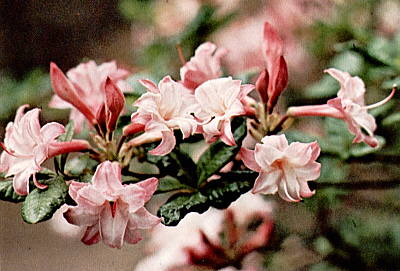QBARS - v29n2 Three Cinderellas
Three Cinderellas
Meldon Kraxberger, Portland, Oregon
There are buried among the dozens of old varieties of deciduous azaleas (many not even in this country) two clones and one species of superlative grace. The first two are products of a slower, quieter, less gaudy age than this; the third is a pure species, perfect as it is. All three are unfairly overlooked today because their beauty is more muted than the modern hybrids, but it is there for all to see; and because until the a d v e n t of mist propagation, the clones were grafted with all the attendant problems of high prices, suckers, and just plain scarcity. The species is common, large and beautiful plants are legion, but- it still is not easy to purchase. These three azaleas are extremely hardy, ordinary in foliage and bush habit, and perform best in a sunny location. All deliver highly-colored autumn foliage as is expected of deciduous azaleas.

|
|---|
R. 'Corneille' Photo by Reuben Hatch |
R. 'Corneille' belongs to the Ghent class which originated in Belgium more than a century ago. The Royal Horticultural Society bestowed upon this plant an A. G. M. in 1969. The fragrant hose-in-hose corollas are tubular in shape, flaring at the mouth, held in a loose cluster, all of a delicious creamy shrimp pink, darker at the edge.
R. 'Homebush' is built on entirely different lines, but still does not look modern. This is an early Knaphill and also received the A. G. M. in 1969. The inflorescence is a perfect round globe, made up of doubled florets of a glowing rose pink. Fragrance is not strong. One cannot choose between these two, one must have both after seeing them.
The third neglected beauty is R. luteum (Azalea pontica), a species from Asia Minor, introduced to cultivation in 1793. This was given an A. G. M. in 1930 on its own merits as a plant, not as understock for other azaleas. R. luteum develops into a large bush literally smothered in May with small trusses of small yellow flowers. These flowers are probably the most intensely fragrant of all deciduous azaleas. The three azaleas would add charm and spice to any collection of modern hybrids. One wonders how many more Cinderellas there are waiting to be discovered.

